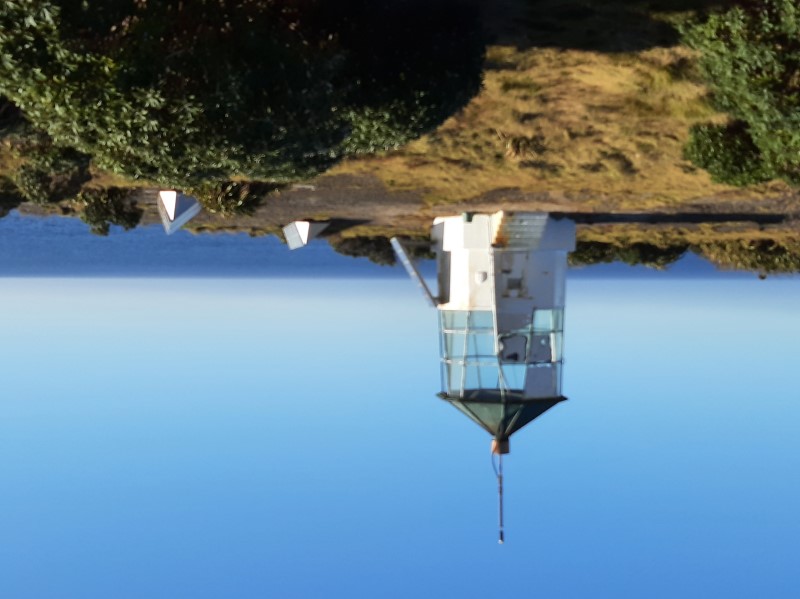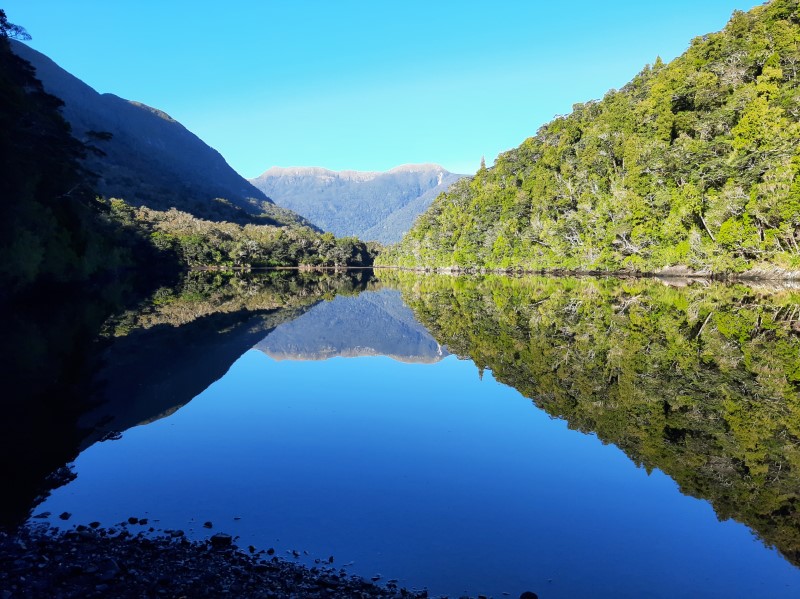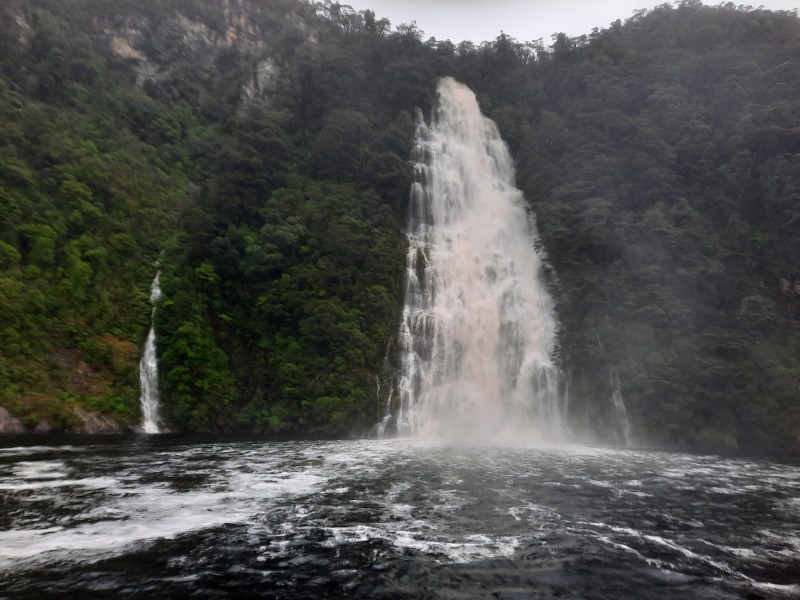
Fiordland
Embarking on a 10-day adventure in Fiordlands with the Affinity Cruises proved to be a serendipitous delight when two
unexpected slots became available. The rapid orchestration of flights to Queenstown, bus transfers to Te Anau,
and securing accommodations reflected our eagerness to seize this impromptu opportunity, even momentarily
halting a garden project in Wellington. Catering specifically to those aged 50 and above, Affinity Cruises
offers an intimate experience with small groups aboard a charming vintage vessel boasting eight cozy cabins,
three toilets, two showers, a main lounge, and expansive deck spaces.
The allure of Affinity Cruises lies in the unhurried pleasure of sightseeing, occasional walks, and fishing. The
modest size of the boat fosters a congenial atmosphere, providing a unique opportunity to connect with fellow
passengers while immersing oneself in the breathtaking landscapes of Fiordland. This well-curated blend of
comfort and exploration makes Affinity Cruises an appealing choice for those seeking a leisurely escape amidst
the stunning scenery of New Zealand's South Island.












Preservation Inlet
19-Jun-2021
Early in the morning, the anticipation hung thick in the air as we were picked up by the helicopter company,
ready for a journey into the heart of nature's grandeur. The whirring blades lifted us from Te Anau and
whisked us over the rugged landscape towards Preservation Inlet, nestled within the embrace of Fiordland
National Park.
The very name, "Preservation Inlet," whispered of tales from a bygone era, echoing the 19th-century
significance it held. Back then, it stood as a sanctuary for ships, a bastion for the preservation of food
and supplies during the age of European exploration and trade. Today, it retains that air of historical
charm, surrounded by steep mountains, dense forests, and landscapes that seem to defy the touch of
modernity.
Our airborne arrival set the stage for the adventure to come. The inlet, with its wild and untouched
character, welcomed us from the sky. From the floating landing platform, we made our way onto the
Affinity,
a vessel that would be our floating home for the next ten nights. The crew greeted us warmly, and after
stowing our luggage in the snug cabins, we set sail towards Tarawera Mine in Isthmus Sound.
As we glided through the pristine waters, the remnants of failed ore extraction ventures dotted the
landscape, a testament to the challenges faced by those who sought fortune in this remote corner of the
world. The Tarawera Mine, an emblem of those endeavors, stood silent, telling tales of endeavors long past.
Our journey continued to the Old Oil Store, a place that marked the beginning of a 2-3 hour walk to
Puysegur
Point. New Zealand's most South Western Lighthouse awaited us there, perched on the edge of
Fiordland like a
sentinel of isolation. The realization of the area's ecological fragility struck us when a fellow
traveler
pointed out the eerie absence of bird sounds - an unintended consequence of introduced pests.
Kisbee Lodge, a hidden gem in Kisbee Bay, beckoned next. A privately owned retreat, it
stood within sight of
Coal Island, offering shelter to those seeking solace in the heart of nature. The lodge, shrouded in
exclusivity, opens its doors to volunteers engaged in the noble pursuit of conservation on Coal Island.
The Preservation Inlet unfolded before us over the next couple of days. We sailed at a leisurely pace
through Isthmus Sound and Te Awaroa/Long Sound, each bend revealing a new facet of Fiordland's
untouched
beauty. The air was filled with a sense of adventure and reverence for the land and its history - a history
that echoed in the creaking timbers of the Affinity as it navigated the waters of Preservation Inlet.
Chalky Inlet
21-Jun-2021
Sailing the Chalky Inlet on the morning of June 21, 2021, marked a seamless continuation of our established
routine. The day began with a hearty breakfast, followed by the familiar ritual of lifting anchor as we set
sail toward the day's point of interest. The morning unfolded with the option to enjoy the scenic views
either from the deck of the boat or through exploratory walks ashore, providing a well-rounded experience
for enthusiasts of both maritime landscapes and on-foot exploration.
Our afternoons were punctuated by a satisfying lunch that rejuvenated our energy for further activities.
Whether it was more sailing, fishing, or simply unwinding on the deck, each moment held the promise of new
discoveries against the stunning backdrop of Chalky Inlet. As the sun began its descent, the skipper
skillfully dropped anchor in one of the serene sounds, ushering in the evening camaraderie. Pre-dinner
nibbles and drinks in the main lounge set the stage for engaging conversations, covering a diverse range of
topics that added depth to our shared experiences.
Navigating from one inlet to another, the transition from smooth waters to the open ocean served as a
reminder that the sea, while enchanting, can also be capricious. The unpredictability of the open waters
presented a challenge that heightened our awareness and appreciation of the maritime journey.
Our exploration of Chalky Inlet included a poignant visit to the wreck of the GSS Stella, a
schooner-rigged
steamship that faithfully served the New Zealand government from 1876 to 1926. Deliberately scuttled in
North Port, Chalky Inlet, the remains of the GSS Stella stand as a historical landmark, honoring its
decades-long service and the pivotal roles it played in New Zealand's maritime and exploratory history.
Our journey also took us through Cunaris Sounds, culminating in a night spent in
South Port before we set
sail for the enchanting Dusky Sounds. Each leg of our voyage offered a unique tapestry of experiences,
combining the tranquility of the sounds with the thrill of exploration and the rich history that is woven
into the maritime landscapes of Chalky Inlet. As we navigated these waters, we found ourselves immersed in a
balance of routine and the unexpected, creating memories that would endure far beyond the journey's
end.






Dusky Sound
22-Jun-2021
Cruising Dusky Sound proved to be an immersive and tranquil experience, showcasing the untamed beauty of New
Zealand's wilderness. Our journey began with a leisurely 6-hour sail from South Port to Anchor Island,
offering ample time to appreciate the stunning coastal landscapes along the way.
Upon reaching the shores of Anchor Island via a small rubber dinghy, we were greeted by a mesmerizing colony
of seals. The young seals frolicked in the shallow waters, adding a playful charm to the scene, while some
of the adults sought refuge in the depths of the forest, creating a harmonious balance of nature's elements.
One of the highlights of our excursion was the visit to Resolution Island, named after
Captain James Cook's
ship Resolution, which landed here during Cook's Second Voyage in March 1773. The island stood as an
important sanctuary, free from possum colonization and boasting a diverse range of habitats, from wetlands
to forests to alpine areas. The island's highest peaks, reaching around 1000 meters, provided a
spectacular
backdrop for our exploration.
Embarking on a two-hour walk across Pigeon Island, we delved into the rich history of the
region. Our
journey led us to Richard Henry's base and Facile Harbour, the site of New Zealand's first
official
shipwreck. The historical significance of these locations added depth to our appreciation of the area's
maritime heritage. Earshell Cove, another site we explored, further enriched our understanding of the
ecological tapestry woven throughout Dusky Sound.
Over the course of our stay, we leisurely explored various parts of the sound, attempting to check crayfish
pods with mixed success. Days were spent lounging on the deck, where we indulged in breathtaking views of
surrounding hills and cascading waterfalls. Fishing became a rewarding activity as we added fresh catches to
our menu, enhancing the culinary aspect of our maritime adventure.
Observing dolphins frolicking in the waters added a touch of enchantment to our days, further emphasizing
the abundant marine life thriving in Dusky Sound. While soaking up the serenity, we also attended to
practical aspects of the journey, such as refilling our water tanks, ensuring a self-sufficient and
sustainable voyage.
In conclusion, our time cruising Dusky Sound was a harmonious blend of exploration, relaxation, and
appreciation for the rich natural and historical tapestry that defines this pristine corner of New Zealand.
The experience left us with a deep sense of connection to the land and its marine inhabitants, a testament
to the region's enduring allure.
Vancouver Sound
25-Jun-2021
Cruising through Vancouver Sound proved to be a captivating and diverse experience, offering
a mix of natural wonders and unpredictable weather conditions. Sailing via Acheron Passage
was a highlight,
where steep cliffs adorned with cascading waterfalls created a mesmerizing spectacle. The rain, while
potentially challenging, added to the allure by filling the waterfalls and providing avid photographers with
fantastic opportunities to capture the beauty of the surroundings.
One notable aspect of the cruise was the captain's openness to exploration and the satisfaction of the
passengers. The willingness to navigate close to the waterfalls and even sail multiple times along the same
cascade allowed for an immersive and personalized encounter with these natural wonders. This flexibility
enhanced the overall experience, providing passengers with the chance to revel in the magnificence of the
waterfalls from different perspectives.
As the journey continued along John Islands, the decision to anchor for the night at Beach Harbour between
Harbour Island and the mainland demonstrated a commitment to passenger safety and comfort. The
well-protected location shielded the cruise from adverse weather elements, ensuring a peaceful and secure
night's stay for all on board.
The subsequent day took the cruise through Breaksea Sound, the Broughton
Arm, and the Vancouver Arm,
offering a diverse range of weather conditions. From heavy rains and winds to still moments when the sea
resembled a vast mirror reflecting the surrounding cliffs, passengers experienced the dynamic nature of New
Zealand's coastal weather. Despite the challenges posed by varying weather extremes, the cruise
maintained
its charm, providing passengers with a unique and ever-changing seascape.
One aspect that added an element of unpredictability to the journey was the competition with dolphins and
small sharks for food during fishing activities. Unlike previous sounds, the fishing experience in Vancouver
Sound proved to be less successful. This, however, added an unexpected twist to the expedition, reminding
passengers of the untamed and wild nature of the marine environment.
In conclusion, cruising through Vancouver Sound in New Zealand offered a balanced blend of natural beauty,
adventurous exploration, and unpredictable weather conditions. The captain's flexibility, coupled with
strategic anchoring choices, ensured a safe and enjoyable experience for passengers, allowing them to
appreciate the rugged magnificence of the New Zealand coastline in all its diverse glory.






Doubtful Sound
27-Jun-2021
Embarking on a cruise through Doubtful Sound proved to be an immersive journey into the heart of New
Zealand's Fiordland, offering a blend of natural wonders, historical insights, and serene landscapes.
Our adventure began with a three-hour sail from Vancouver Sound, navigating the unpredictable waters of the
Tasman Sea. For some passengers, the sight of Shelter Island served as a welcome relief, a reassuring marker
signaling respite from the challenges of seasickness.
Doubtful Sound, initially dubbed "Doubtful Harbour" by Captain Cook in 1770,
carried a historical aura. Captain Cook, uncertain about its navigability under sail, refrained from
entering the inlet. It was later renamed Doubtful Sound by Sealers and Whalers. Spanning 40 kilometers, it
stands as the deepest and most
secluded among the 14 fiords in the region. Its allure lies in the breathtaking glacially carved valleys,
cascading waterfalls, lush rain forests, and a rich array of wildlife. The fiord proudly hosts New
Zealand's southernmost population of bottle nose dolphins and the charming Fiordland Crested Penguins.
Our initial stop at the First Arm Mooring provided an excellent opportunity for passengers
to capture the
scenic beauty of Doubtful Sound, creating lasting memories through photographs. As we sailed past the
Blanket Bay Hotel, a relic from the 1960s, the air was tinged with a sense of nostalgia.
Once a vital hub
supplying local fishermen with bait and fuel until the 1990s, the hotel's name, bestowed during the
Acheron
survey of 1851, hinted at the misty ambiance surrounding it.
The first day of our voyage was dedicated to leisurely sightseeing as we sailed toward Macdonnell
Island,
gradually absorbing the grandeur of our surroundings. Upon waking the next morning, we were greeted by the
enchanting sight of snow-capped mountains, a magical spectacle that accentuated the region's natural
splendor. Sailing through Lake Astelia and Thompson Sound to the
Neck Cove, we engaged in a spot of fishing,
with the fortunate release of two small sharks back into their wild habitat under the guidance of the
skipper. The visit to the Crooked Arm and the anchoring at Elizabeth
Island added a touch of tranquility to
our voyage.
On the final day, our journey culminated in Deep Cove, where we rendezvoused with a coach
for an
unforgettable ride over the spectacular Wilmot Pass. A boat trip across Lake Manapouri led
us to Manapouri,
where we boarded a coach back to our accommodation in Te Anau. While waiting for the coach in Deep Cove, we
indulged in a
short walk to explore the Manapouri Tailrace Tunnels, adding a touch of adventure and exploration to the
conclusion of our cruise.
In essence, our expedition through Doubtful Sound seamlessly intertwined the wonders of nature with
historical remnants and recreational pursuits, offering a well-rounded and enriching experience for all
those on board.